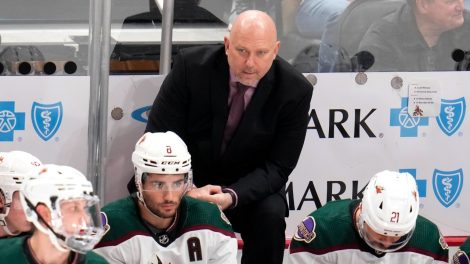Be it Mitch Marner’s tense contract negotiations leaking into training camp, an Auston Matthews legal spat coming to light, a string of injuries to the top line, five sixths of the starting defencemen embarking on critical contract years, or the endless stream of fan criticism directed at head coach Mike Babcock, the 2019-20 season just feels different in Toronto.
A lot more tense. A little less fun.
The mood that surrounded that freewheeling group of skilled kids who dangled and dazzled their way into the post-season and nearly caused the Presidents’ Trophy–winning Washington Capitals to pucker in 2017? It feels foreign and quaint now.
After a quarter-century without one, the city has now tasted the celebratory joy that springs from choking the downtown core with a championship parade.
It’s the hockey team’s turn to deliver one.
And it is under that pressure — self-imposed, too; these guys pass around a Raptors game ball after regular-season wins — that the Maple Leafs have roller-coasted their way to a 9-7-4 start.
"Inside, I think we’re fine. We know we haven’t played to the best of our ability. It’s in here," Jake Muzzin says. "We’re hungry to be better."
MOST IMPORTANT DEVELOPMENT
For all of the Maple Leafs’ issues — and, yes, there are a few — perhaps the most important development is that they are learning the struggle is real.
Whereas the 2018-19 Leafs cruised through autumn, scoring in bunches and never going more than a couple games without getting back in the W column, this heavily turned-over group has been operating under the weighty expectations that come from life-altering signing bonuses and three consecutive first-round playoff exits.
On and off the ice, there has been no shortage of turmoil to rummage through. But just ask the 2019 St. Louis Blues, 2018 Washington Capitals or 2017 Pittsburgh Penguins if their marathons didn’t hit a wall at some point.
Staying race-relevant in the face of some first-quarter adversity should serve the group well in the long run. And knowing you can still produce the NHL’s second-most even-strength goals (54) when you’re not yet performing to max capacity should serve as a massive sign of encouragement.
"I just like the fact that our guys seem to be enjoying each other more, getting to know each other better," Babcock says. "We have more energy as a group, seem to be playing better."
[snippet id=4167285]
MOST WORRISOME DEVELOPMENT
Ooh. This is as difficult as picking your least-favourite child. Do we go with the Leafs’ penchant for turnovers (251, fourth-most overall)? Or minor penalties (76, third-most overall)? Or giving the impression they can be pushed around?
We could focus on the faulty penalty kill (75.3 per cent, eighth-worst overall) or perhaps their rash of injuries. Then there’s the infuriatingly slow starts, which have resulted in surrendering the game’s first goal 15 out of 20 times. And, you may have heard, their utter inability to win a game — five and counting — unless Frederik Andersen is the starter.
Let’s go with the power play, which is especially interesting since it’s supposed to be an area of strength. One that, theoretically, was to grow only more deadly once PP guru Paul McFarland took the reins. And yet even with its star-studded, talent-laden, $41.9-million top unit, the Leafs’ power play is operating at a success rate of just 17.6 per cent (20th overall) and is having great difficulty gaining the zone to set up.
Sure, injuries haven’t helped, but they alone cannot account for a 4.2 per cent and 12-spot drop-off from last year.
TOP SIX FORWARDS GRADE: B
The overlapping injuries to Zach Hyman (knee), John Tavares (finger) and now Mitch Marner (ankle) will prevent us from watching one of hockey’s most dominant lines until we’re at least 30 games in—and the trickle-down effect has taken its toll.
Marner struggled to carry his line 200 feet with Tavares out, Tavares’ tap-ins-per-game ratio is about to take a dive without Marner’s creative input, and the blue-collar grit and penalty-killing of Hyman — the best forechecker in hockey, according to his coach — was sorely missed for 19 games.
The only Leafs line that has essentially remained untouched through the 20-game mark, Andreas Johnsson–Auston Matthews–William Nylander, has been phenomenal offensively. Those three have accounted for 26 goals and 54 points.
While some tough defensive matchups (see: Bergeron, Patrice) reminded that Matthews’ own-zone play is still a work in progress, the 22-year-old is on pace for a 53-goal, 106-point season.
Friendly reminder: At this point last season, Nylander was still relaxing in Sweden while the league was speeding away from him with the windows down. He has five goals in his past five games.
[snippet id=4745221]
BOTTOM SIX FORWARDS GRADE: B+
When the forwards are all healthy, which won’t happen until we’re singing Christmas carols (at best), Leaf Nation should continue to fall in love with the revamped third unit of souper rookie Ilya Mikheyev, versatile centre Alexander Kerfoot, and speed demon Kasperi Kapanen. We love the mix of tenacity, pace and skill this trio brings. And they’ve combined for 30 points already.
"We can have an unbelievable line there with [Mikheyev] and [Kapanen] once we get it organized and they get to know each other and feel good," says Babcock, who has also instilled more trust in key defensive situations in his Frederik Gauthier–led fourth unit.
"Goat has been important for us. Really important for us."
That a dependable worker like Trevor Moore drops to the fourth line when everything is back to normal proves that winger depth remains Toronto’s strong suit. And plenty of capable Marlies are just itching to get a chance.
DEFENCE GRADE: C+
None of 2018-19’s blueline pairings carried over to this season, and the unfamiliarity shows. The Leafs surrender 33.3 shots per game (11th-most overall) and have given the puck away 251 times, more than all but three clubs in the NHL. On paper, the personnel isn’t bad at all, but chemistry is a work in progress, and injuries have played a negative factor here.
Despite his 17 points, top D-man Morgan Rielly is battling through an undisclosed ailment that has kept him out of a handful of practices, and he and new partner Cody Ceci are still finding their groove.
Tyson Barrie is simply not himself. His switch to PP2 duty and the Eastern Conference has been rocky, and as an impending UFA, continued struggles could affect his payday. (Just ask Jake Gardiner.) Acquired as a defenceman with 60-point pedigree, Barrie is on pace for just 20 points and has yet to score his first goal as a Leaf.
"The biggest change for him, for sure, is the puck touches on the No. 1 power play. You just don’t get any," Babcock says. "That’s where you got all your feel. Now you’ve got to reinvent yourself a little bit."
Now that Travis Dermott is healthy and perma-scratch Justin Holl has finally established himself in the lineup, Toronto appears to have finally found a bottom pairing it can depend on.
"We really feel our pairs are starting to come, all three of them," Babcock says. "Pairs take longer – I believe – than lines, just because you’ve got to know the nuances of one another and feel it out and learn what you can do for one another to make each other better."
[snippet id=3816507]
GOALIE GRADE: B+
One could, again, make the case that Andersen is a top-five goaltender in the world. After a typically inconsistent October, which saw a rare mid-game pull in a Tampa Bay rout, Andersen has posted a remarkable 7-1-3 record, earning his club 17 of a possible 22 points despite routinely getting outshot and playing a key role in the Leafs’ record-breaking 11-round shootout win in Philadelphia.
Steady Freddie says he’s been consciously trying to play a little deeper in his crease and be more attentive with his reads. The adjustments are paying off.
"We talk every day about how he keeps our team grounded," Marner says. "He keeps us in games a lot of times."
"Freddie has been a rock for us all year," adds Matthews.
What could possibly prevent us from handing out an A in this category? Backup Michael Hutchinson started five games and lost them all before losing his job as well, to Kasimir Kaskisuo (zero NHL games played).
With nine more back-to-backs on deck and workhorse Andersen on pace for a hefty 68 appearances, the backup gig is an issue again. Godspeed, Kasimir.
QUARTER MARK AWARDS
MVP: Frederik Andersen
Most improved player: Justin Holl
Best defensive player: Jake Muzzin
Most physical player: Jake Muzzin
[relatedlinks]









